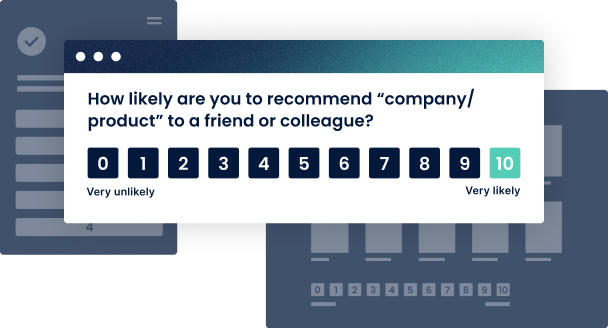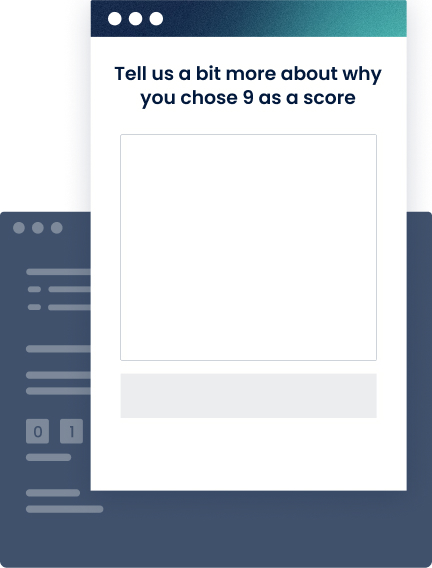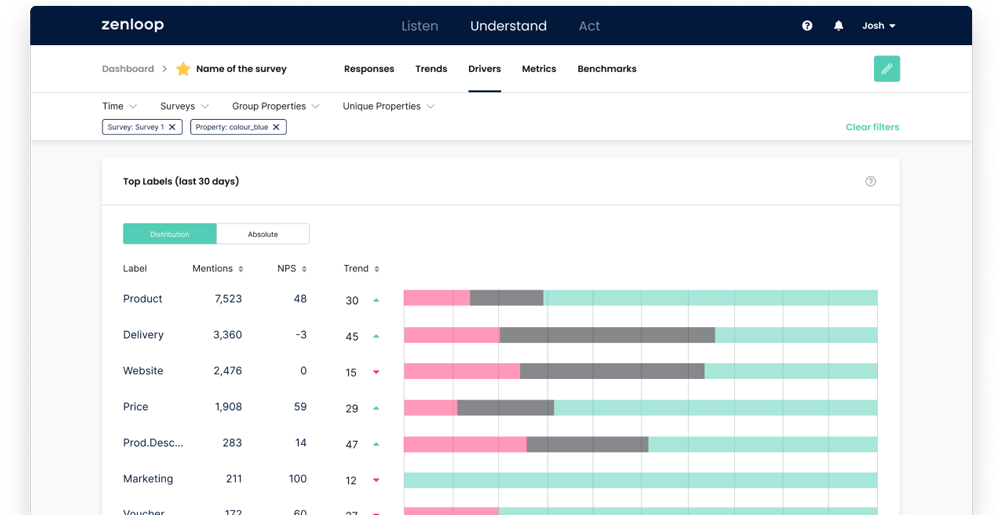What Are NPS® Surveys?
Improve Business Success with the Right Questions.
If you don‘t ask, you‘ll never know! That‘s a lesson that we learn from a young age. It‘s when companies take this proverb to heart that they can improve their customer relationships and use targeted questions to increase their sales – the Net Promoter System makes it possible.

When customers are asked for feedback at key interaction points on the website, they act as an endless source of information. Website surveys give a deeper insight than the statistical evaluation of endless clicks. They provide a forum for suggestions and a channel for deeper customer insights. The results allow companies to create profiles of their customers, accurately identify customer needs, or measure the impact of new products, websites, or experiences.
The most important thing: this does not require endless online questionnaires. Instead of looking for the proverbial needle in a haystack through the use of indiscriminate questions, more and more organizations choose the easy route and rely on NPS surveys. These are based on a metric that provides information on customer loyalty and satisfaction based on a single key figure — the Net Promoter Score.
How Are Online NPS Surveys Built?
NPS surveys follow the „KISS“ principle (Keep It Short and Sweet) and these so-called micro-surveys impress with their short and simple structure. Both companies and participants profit from such an approach. As the survey takes only one to two minutes, it is not particularly time-consuming for the participants and companies benefit from a high number of participants. At the same time, NPS surveys are capable of winning over support from the board and management. They are not only easy to understand, but also require no complicated analysis. Even the choice of words is simple. In the best-case scenario, it is based on the language used by the target group. After all, participation should bring joy and not be an annoying duty.
The standard NPS question asks the customer to rate the surveyed product, company, or service on a scale. This scale ranges from 0 (very unlikely) to 10 (very likely), but other scales can also be used. Based on their answer, participants are divided into promoters (9-10), passives (7-8), and detractors (0-6). The higher the number a customer chooses, the more likely he or she is to recommend the company. The default NPS question is:
“How likely is it that you would recommend us / our product / our process (brand/product/touch point) to a friend or colleague?”
For Fred Reichheld, the developer of the Net Promoter Score, this is the only important question. Why? His research revealed that the Net Promoter Score is the most effective measurement of customer satisfaction. Only really satisfied customers recommend a product or service to friends or acquaintances.
The evaluation question is then followed by an open question. Here the customer is asked to justify their choice of score:
What is the most important reason for the review you just gave?
An empty text field offers the possibility to express praise and criticism in detail. The open question does not follow the evaluation question without reason – customers are more willing to give additional feedback in text form when the question relates to a review they have previously given. Organizations get to know the experiences and thoughts of their customers in more detail. Finally, the Net Promoter Score is calculated from all responses, which can range between +100 and -100 depending on the willingness of the customers to recommend. The NPS survey can also be used to determine employee loyalty. In this case, it is called the ENPs or Employee Net Promoter Score.

How Are NPS Surveys Used?
Many roads lead to Rome – the micro survey can be shared with the customer in different ways. It can be questioned directly in the shop, via email, online questionnaire, SMS, or within a mobile app. In most cases, however, the NPS survey takes place online in the following ways:
- On-Site and In-App
NPS surveys integrated into the website provide a great opportunity to receive real-time feedback. In-app surveys guarantee a particularly high willingness to participate. They usually pop up directly on the users’ mobile phones while using the service or product on the website. E-commerce websites, blogs, or magazines can incorporate NPS surveys into individual article pages or the landing page. Even when the survey should appear can be determined. Most popular are so-called exit surveys, which ask the user for their feedback shortly before leaving the website.
- Email
Another way to assess customer opinions is via email survey. However, companies should be aware that this requires more effort on the customer‘s part: he or she needs to open their email program, read the email, and finally click through to the questionnaire. In our fast-paced society, this can result in users abandoning the process halfway and showing less willingness to participate.
However, email surveys sent after a certain time interval leads to a much more useful customer evaluation. The customers have had the opportunity to get to know the product or service better due to the time interval between purchase and receiving the link to the survey. This allows them to take a closer look at the product and reflect on their experience. Although in this case, fewer people take part in the survey, their responses are often more detailed.
When Should NPS Surveys Be Sent?
It’s all about timing. Not only content but also when it arrives determines the success of an NPS survey. But when is the best moment to ask customers for feedback? A look at the individual stages of the Customer Journey can provide orientation.
Before purchasing a product, a customer usually goes through different stages. In marketing, these stages are also described as touchpoints that a consumer has with a brand, service, or product. This is a good reason to ask the customer multiple times – at the end of each stage – for feedback, increasing the likelihood that it will be given truthfully.
At which touchpoint, that is to say, at what point, should the survey take place? Feedback is often different at each stage. Therefore, the company should, first of all, know what it wants to know from its customer. Anyone who asks their customers about their satisfaction with a product before the end of the ordering process may receive no, or only fictitious feedback.
How Can You Vary The NPS Question?
The strength of the classic NPS question lies in its generality. It is short, simple, and easy to understand. However, company-specific specifics are not taken into account. Many Net Promoter Systems, therefore, make it possible to personalize the standard NPS question and adapt it to the respective target group. If organizations are primarily interested in feedback about their product, brand, or performance, they should also clearly communicate this. In this way, the focus can be shifted away from the company to a specific product that has just been launched, renewed, or advertised. Product managers in particular benefit from the answers. The following questions can be used as an alternative to the standard question:
What did you miss or what disappointed you in dealing with us?
With this question, companies ask for constructive criticism. Users and customers are encouraged to discuss the aspects of a performance or product they do not like. Many people are reserved when it comes to openly express criticism. This question actively encourages them to do so. Customers get the feeling that they are not indiscriminately nagging but can contribute to improving the service with their criticism.
How can we improve your experience?
This question is for customers who have left a negative review. They are asked to make practical suggestions on how to improve the product or performance. At the same time, the answers help the company prioritize which topic is at the top of the customer’s agenda and which changes are most urgent.
What do you particularly appreciate about our product or service?
Often companies offer extensive products or services with different details, without focusing on a particular point. This question gives the customer the ability to specify which of the various features they value or use most. Companies get a better sense of customer needs regarding a product. Decisions on which features to renew or improve in the future can be made easier and with more confidence.
What do you like the most/least about our product/our company?
Anyone who asks this question immediately after interaction with the customer increases the quality of feedback. It is suitable for both fans and critics. The answers help you discover new perspectives and use them for marketing campaigns. Often, the answers also reveal new ways to position the product and its strengths even more purposefully or to attract fans as testimonials. On each landing page, the positive reviews create confidence among potential customers.
How does one draw qualitative or quantitative from NPS?
The classic NPS question gives a quantitative result. The customer expresses his willingness to recommend in the form of a number. Most often, the result refers to the company in general. The Net Promoter Score can also be determined for individual company areas, functioning like a magnifying glass, enlarging and illuminating details. Thus, the question at the end of an order process can query satisfaction with the order process, whereas sending the question a few weeks after purchase can provide illuminating information about product satisfaction.
Even with detailed analyses and promising forecasts, the Net Promoter Score is and remains only a number. A number alone does not provide answers to why the customer chose to give a particular score. If companies want to use the NPS as a basis for decision-making and action, the Net Promoter Score alone is not enough.
Hier kommt der zweite Teil der NPS-Umfrage in Spiel, denn mit dem offenen Antwortfeld haben die Teilnehmer die Möglichkeit, ihre Bewertung zu begründen. Die Zusatzfrage räumt Stolpersteine aus dem Weg. Denn mit den qualitativen Antworten wird den Unternehmen der Schlüssel zum weiteren Erfolg quasi auf dem Silbertablett serviert.
This is where the second part of the NPS survey comes into play because the open answer field gives participants the opportunity to justify their evaluation. The supplementary question brings clarity. With qualitative answers, companies are given the keys to success on a silver platter.
The answers provide valuable impulses for almost all areas of the company and help to
- optimize processes and products,
- create new innovation,
- improve customer service and increase customer loyalty,
- detect company crises early on,
- define the strategic orientation for the company,
- avoid erroneous decisions,
- deliver topics for marketing and public relations and therefore
- polish up the corporate image.
How Do NPS Surveys Differ from Ordinary Online Surveys?
Online customer surveys are usually quite broad. If a company still knows little about its customers, such extensive website surveys can provide important basic data. For example, this can be socio-demographic data such as age, gender, or marital status. Surveys can also be used to query the exact requirements, needs, and wishes of their different user groups. This often results in a catalog of questions that should cover many different facets of a company, product, or service in as much detail as possible. However, the bounce rate often grows with the length of the survey. The number of participants is small and because of their size, online surveys are often conducted only annually.
NPS surveys, on the other hand, focus on two key topics. They ask for customer satisfaction and leave recipients free to express praise, criticism, or potential for improvement with the open response field. Because the survey takes place at specific touchpoints, companies also avoid asking customers for feedback in areas where they haven’t had any contact points. Due to the brevity, many customers are often willing to take part in the survey. In addition, the survey can be conducted several times a year and the results can be compared at regular intervals. Positive as well as negative developments become more apparent and thus gives the company the chance to react more quickly.
Compared to traditional online surveys, micro surveys impress with
- Real-time trends in customer satisfaction and loyalty,
- High response rates,
- And detailed insights into customer touchpoints.
Summary
Compared to traditional website surveys, NPS surveys are simple, fast, and cost-effective. The mini-surveys provide information about customers’ willingness to recommend and thus possess a relatively high level of relevance with regard to customer loyalty. Depending on which information a company wants to collect, the micro survey can also be used at different stages of the customer journey. Rather than just asking customers for feedback about the company, more and more companies ask customers to evaluate individual products, their brand, or their performance. The qualitative answers thus obtained can provide valuable input for almost all areas of the company and thus drive change within the organization.
Further Reading:
Design NPS surveys with zenloop






